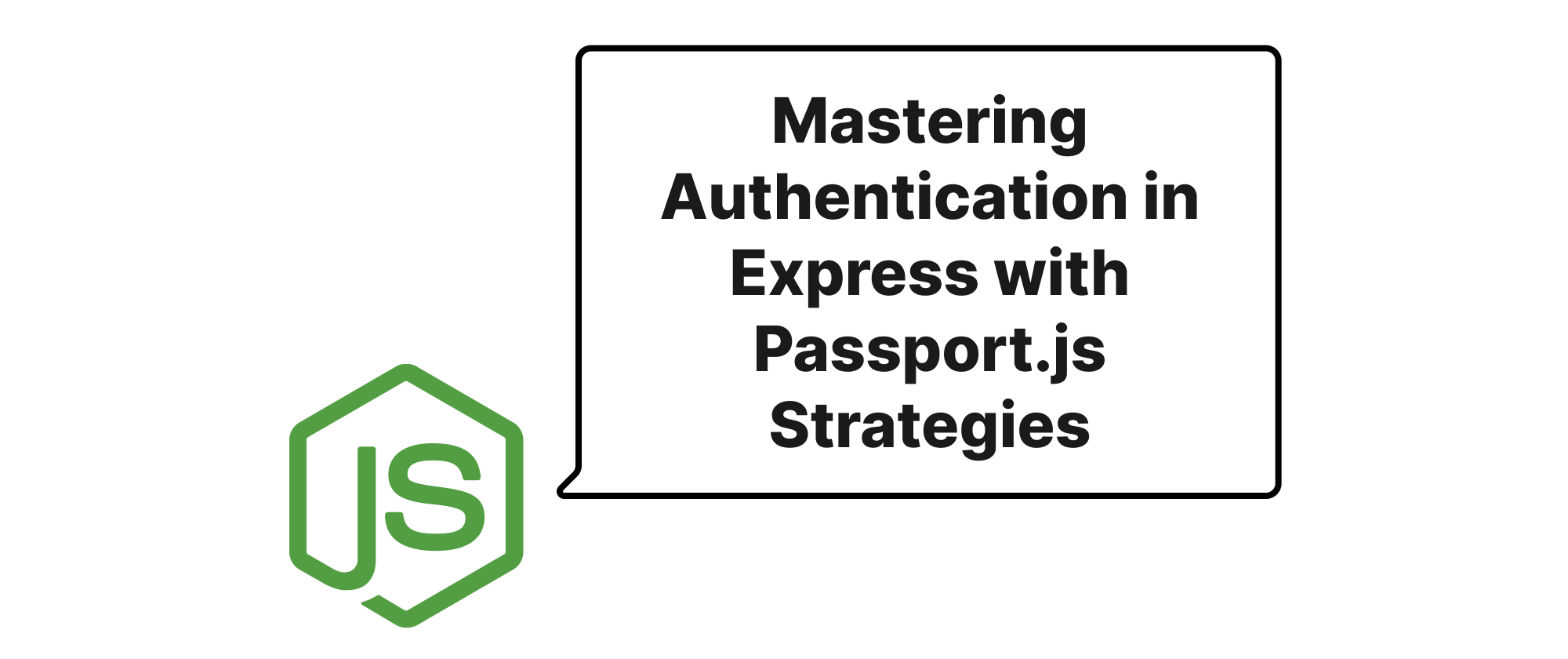Mastering Authentication in Express with Passport.js Strategies
Takashi Yamamoto
Infrastructure Engineer · Leapcell

Introduction
In today's interconnected digital landscape, almost every web application requires a robust and secure authentication system. From safeguarding sensitive user data to personalizing user experiences, reliable authentication is the bedrock of modern application development. However, building an authentication system from scratch can be a daunting task, fraught with security pitfalls and complex implementation details. This is where Passport.js steps in. Passport.js is the de facto authentication middleware for Node.js, offering a flexible and modular approach to authenticating requests. It provides a clean API that allows developers to "plug in" various authentication strategies, ranging from traditional username/password combinations to modern token-based and social logins. This article will delve into the intricacies of Passport.js, exploring how to implement local, JSON Web Token (JWT), and common social login strategies within an Express.js application, providing you with the knowledge and tools to build secure and scalable authentication in your projects.
Core Concepts of Passport.js
Before diving into implementation, let's establish a common understanding of the core concepts central to Passport.js:
- Strategies: At the heart of Passport.js are "strategies." A strategy is a self-contained module that handles a specific type of authentication. For example,
passport-localhandles username/password authentication,passport-jwthandles JWT verification, andpassport-google-oauth20handles Google login. Each strategy is configured with specific options and implements averifyfunction. - Verify Function: This is the most crucial part of any Passport.js strategy. The
verifyfunction is responsible for finding a user based on the credentials provided by the strategy (e.g., username and password for local strategy, token for JWT strategy, profile information for social strategies). If a user is found and authenticated, it calls adonecallback with the user object. If authentication fails, it callsdonewithfalseor an error. - Serialization/Deserialization: Passport.js often integrates with sessions. When a user successfully authenticates, Passport.js needs a way to store a minimal amount of user information in the session to identify them on subsequent requests. This is handled by
serializeUseranddeserializeUserfunctions.serializeUserdetermines what user data should be stored in the session, anddeserializeUserretrieves the full user object from the database based on that stored data. This process allows subsequent requests to be authenticated without requiring the user to re-enter their credentials.
Implementing Authentication Strategies
Let's now explore how to integrate different authentication strategies into an Express.js application.
Setting up the Basic Express Application
First, ensure you have an Express application set up.
// app.js const express = require('express'); const session = require('express-session'); const passport = require('passport'); const bcrypt = require('bcryptjs'); // For local strategy password hashing const app = express(); app.use(express.json()); app.use(express.urlencoded({ extended: true })); // Configure session middleware app.use(session({ secret: 'a very secret key for session', // Replace with a strong, random key resave: false, saveUninitialized: false, cookie: { maxAge: 24 * 60 * 60 * 1000 } // 24 hours })); // Initialize Passport.js app.use(passport.initialize()); app.use(passport.session()); // Only needed if you're using sessions // Dummy user database for demonstration const users = []; // Passport serialization/deserialization (required for session-based authentication) passport.serializeUser((user, done) => { done(null, user.id); }); passport.deserializeUser((id, done) => { const user = users.find(u => u.id === id); done(null, user); }); // Basic route to check if authenticated app.get('/profile', (req, res) => { if (req.isAuthenticated()) { res.send(`Welcome, ${req.user.username}!`); } else { res.status(401).send('Not authenticated'); } }); const PORT = process.env.PORT || 3000; app.listen(PORT, () => { console.log(`Server running on port ${PORT}`); });
1. Local Strategy (Username/Password)
The local strategy is the most fundamental authentication method, relying on a username and password stored in your database.
Installation:
npm install passport-local --save
Implementation:
// app.js (add to existing app.js) const LocalStrategy = require('passport-local').Strategy; // Register a dummy user for testing bcrypt.hash('password123', 10, (err, hash) => { if (err) throw err; users.push({ id: '1', username: 'testuser', password: hash }); }); passport.use(new LocalStrategy( async (username, password, done) => { try { const user = users.find(u => u.username === username); if (!user) { return done(null, false, { message: 'Incorrect username.' }); } const isMatch = await bcrypt.compare(password, user.password); if (!isMatch) { return done(null, false, { message: 'Incorrect password.' }); } return done(null, user); } catch (err) { return done(err); } } )); // Local login route app.post('/login', passport.authenticate('local', { successRedirect: '/profile', failureRedirect: '/login', // You would typically render a login form here failureFlash: true // Requires connect-flash middleware })); app.get('/logout', (req, res) => { req.logout((err) => { if (err) { return next(err); } res.redirect('/login'); // Redirect to login page after logout }); });
Explanation:
- We initialize
LocalStrategyand provide averifyfunction. - The
verifyfunction takesusername,password, and adonecallback. - Inside
verify, we look up the user in ourusersarray (in a real app, this would be a database query). - If the user is not found, or if the password doesn't match after using
bcrypt.compare,done(null, false, { message: ... })is called to indicate authentication failure. - If credentials are valid,
done(null, user)is called, passing the authenticated user object. - The
/loginPOST route usespassport.authenticate('local', ...)to trigger the strategy.successRedirectandfailureRedirecthandle where the user is sent after authentication.
2. JWT Strategy (Token-Based)
JWT (JSON Web Token) authentication is widely used for stateless APIs. Instead of sessions, a server sends a token to the client upon successful login, which the client then includes in subsequent requests for authentication.
Installation:
npm install passport-jwt jsonwebtoken --save
Implementation:
// app.js (add to existing app.js, make sure to add jwt dependency as well) const JwtStrategy = require('passport-jwt').Strategy; const ExtractJwt = require('passport-jwt').ExtractJwt; const jwt = require('jsonwebtoken'); const JWT_SECRET = 'your_jwt_secret'; // Replace with a strong, random key // JWT Strategy options const jwtOptions = { jwtFromRequest: ExtractJwt.fromAuthHeaderAsBearerToken(), secretOrKey: JWT_SECRET }; passport.use(new JwtStrategy(jwtOptions, async (jwt_payload, done) => { try { const user = users.find(u => u.id === jwt_payload.sub); // 'sub' is standard for user ID if (user) { return done(null, user); } else { return done(null, false); } } catch (err) { return done(err, false); } })); // Route for generating JWT (after successful local login for example) app.post('/api/login-jwt', async (req, res, next) => { passport.authenticate('local', { session: false }, (err, user, info) => { if (err || !user) { return res.status(401).json({ message: info ? info.message : 'Login failed' }); } req.login(user, { session: false }, (err) => { if (err) res.send(err); const token = jwt.sign({ sub: user.id, username: user.username }, JWT_SECRET, { expiresIn: '1h' }); return res.json({ user, token }); }); })(req, res, next); }); // Protected JWT route app.get('/api/protected', passport.authenticate('jwt', { session: false }), (req, res) => { res.json({ message: `Welcome ${req.user.username} to the protected JWT route!`, user: req.user }); });
Explanation:
- We define
jwtOptionsto tell the strategy where to find the JWT (e.g., in theAuthorizationheader as a Bearer token) and what secret to use for verification. - The
JwtStrategy'sverifyfunction receives the decoded JWT payload (jwt_payload) and thedonecallback. - It then uses
jwt_payload.sub(typically the user ID) to find the user in the database. - If found,
done(null, user)is called. If not,done(null, false). - The
/api/login-jwtroute first uses the local strategy to authenticate credentials. If successful, it generates a JWT usingjsonwebtoken.signand sends it back to the client. - The
/api/protectedroute usespassport.authenticate('jwt', { session: false })to protect the route.session: falseis crucial here because JWT is stateless and doesn't rely on sessions.
3. Social Login (Google OAuth 2.0 Example)
Social login allows users to authenticate using their existing accounts from platforms like Google, Facebook, or GitHub. This improves user experience and reduces friction.
Installation:
npm install passport-google-oauth20 --save
Setup Google API Project:
- Go to Google Cloud Console.
- Create a new project.
- Navigate to
APIs & Services > Credentials. - Click
+ Create Credentials, chooseOAuth client ID. - Select
Web application. - Set
Authorized JavaScript originsto your app's URL (e.g.,http://localhost:3000). - Set
Authorized redirect URIsto your callback URL (e.g.,http://localhost:3000/auth/google/callback). - You will get a
client IDandclient secret.
Implementation:
// app.js (add to existing app.js) const GoogleStrategy = require('passport-google-oauth20').Strategy; const GOOGLE_CLIENT_ID = 'YOUR_GOOGLE_CLIENT_ID'; // Replace with your actual client ID const GOOGLE_CLIENT_SECRET = 'YOUR_GOOGLE_CLIENT_SECRET'; // Replace with your actual client secret passport.use(new GoogleStrategy({ clientID: GOOGLE_CLIENT_ID, clientSecret: GOOGLE_CLIENT_SECRET, callbackURL: "/auth/google/callback" // This must match your Google Cloud Console redirect URI }, async (accessToken, refreshToken, profile, done) => { try { // In a real application, you would save/find the user in your database // based on profile.id or profile.emails[0].value let user = users.find(u => u.googleId === profile.id); if (!user) { // If user doesn't exist, create a new one const newUser = { id: profile.id, // Using googleId as our primary ID for simplicity googleId: profile.id, username: profile.displayName, email: profile.emails && profile.emails[0] ? profile.emails[0].value : null, // You might want to save more profile data }; users.push(newUser); user = newUser; } return done(null, user); } catch (err) { return done(err, null); } })); // Google Authentication routes app.get('/auth/google', passport.authenticate('google', { scope: ['profile', 'email'] }) ); app.get('/auth/google/callback', passport.authenticate('google', { failureRedirect: '/login' }), (req, res) => { // Successful authentication, redirect home. res.redirect('/profile'); } );
Explanation:
- We configure
GoogleStrategywithclientID,clientSecret, andcallbackURL. - The
verifyfunction for Google takesaccessToken,refreshToken,profile(containing user data from Google), anddone. - Inside
verify, we check if a user with theprofile.id(Google ID) already exists in ourusersdatabase. - If not, a new user is created and added.
- If authenticated,
done(null, user)completes the process. - The
/auth/googleroute redirects the user to Google for authentication, specifying thescopeof authorized permissions. - After successful authentication on Google's side, Google redirects the user back to
/auth/google/callback. Passport.js intercepts this callback, processes the Google response, and calls the strategy'sverifyfunction. - Upon successful verification, the user is redirected to
/profile.
Application Scenarios
- Local Strategy: Ideal for traditional web applications where users manage their accounts directly within your system. Suitable for internal tools or applications requiring strict control over user data.
- JWT Strategy: Best for APIs, mobile applications, and single-page applications (SPAs) where a stateless approach is preferred. It allows for scalable authentication without server-side session storage.
- Social Login: Enhances user experience by providing convenience and reducing sign-up friction. Particularly useful for consumer-facing applications where users prefer to leverage existing accounts.
It's common to combine these strategies. For instance, a user might initially sign up with email/password (local strategy), and then later link their Google account. Or, a web application might use local authentication for general users but expose an API protected by JWT for mobile clients.
Conclusion
Passport.js stands as an indispensable tool for JavaScript developers building authentication into their Express applications. By understanding its modular strategy-based architecture, you can seamlessly integrate a wide array of authentication mechanisms, from traditional local logins to modern token-based and social authentication flows. The flexibility and extensibility of Passport.js empower developers to create secure, robust, and user-friendly authentication systems tailored to the specific needs of their applications, ensuring a solid foundation for any web project. Mastering Passport.js is a fundamental step towards building secure and scalable user-centric applications.


